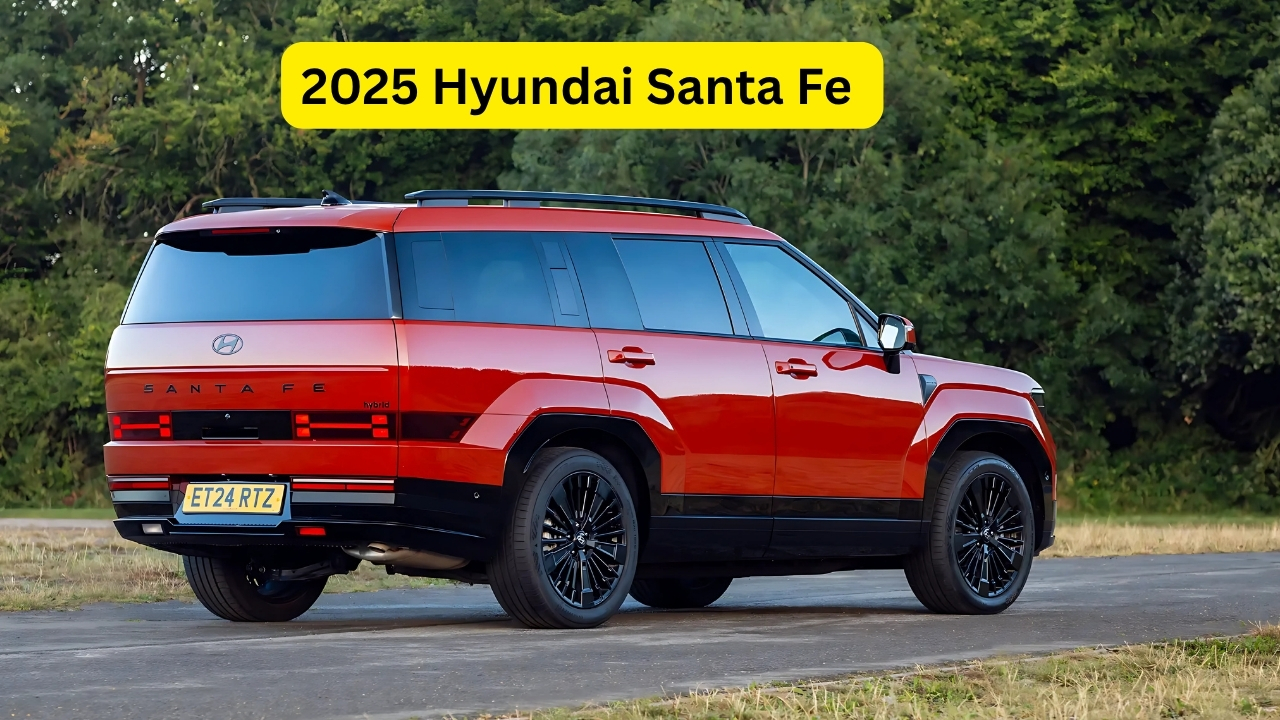The 2025 Hyundai Santa Fe has arrived with a bold redesign and exciting updates, including the introduction of more affordable turbo-petrol variants. These new non-hybrid models expand the Santa Fe lineup, offering buyers a cost-effective alternative without sacrificing the SUV’s signature style, space, and technology. With prices starting at $53,000 before on-road costs in Australia, the petrol-powered Santa Fe delivers robust performance and family-friendly practicality, making it a compelling choice in the competitive midsize SUV market. This article explores the key features, pricing, performance, and appeal of the 2025 Hyundai Santa Fe’s petrol variants, highlighting why they’re a smart pick for budget-conscious buyers seeking value and versatility.
A Bold New Look for 2025
Hyundai unveiled the fifth-generation Santa Fe in 2024, and the 2025 model continues to turn heads with its striking, boxy design. Unlike its predecessors, which blended into the SUV crowd, the new Santa Fe embraces a rugged, Land Rover-esque aesthetic with sharp angles and distinctive H-shaped motifs in the headlights and taillights. This dramatic styling sets it apart from competitors like the Toyota Highlander, Kia Sorento, and Subaru Ascent, giving it a modern, almost cyberpunk vibe that earned it the 2025 Carwow Car of the Year and Family Values Award. The bold exterior isn’t just for show—it enhances practicality, with a larger rear hatch and increased interior space for passengers and cargo.
The Santa Fe’s dimensions have grown, stretching approximately 190 inches in length, making it a perfect middle ground between compact SUVs like the Hyundai Tucson and larger models like the Hyundai Palisade. The boxy shape maximizes cargo capacity, offering a class-leading 79.6 cubic feet with the second and third rows folded, 40.5 cubic feet with the second row upright, and 14.6 cubic feet with all seats in use. This versatility makes it ideal for family road trips, Costco runs, or outdoor adventures.
Introducing Petrol Power: More Affordable Options
One of the most significant updates for the 2025 Hyundai Santa Fe is the addition of turbo-petrol variants, which slot below the existing hybrid models in price. Launched in Australia in December 2024, these non-hybrid versions are powered by a 2.5-liter turbocharged four-cylinder engine, borrowed from the Sonata N Line and Genesis lineup. Producing 206kW (277 hp) and 422Nm of torque, this engine offers a noticeable performance edge over the hybrid’s 1.6-liter turbocharged four-cylinder, which delivers 172kW and 367Nm. Compared to the previous-generation Santa Fe’s 3.5-liter V6 (200kW, 331Nm), the new petrol engine is more powerful and slightly more efficient, with a combined fuel consumption of 9.3L/100km versus the V6’s 10.5L/100km.
The petrol variants are available in three trims: the base Santa Fe, Elite, and Calligraphy, mirroring the hybrid lineup. Pricing starts at $53,000 for the base model, $56,000 for the all-wheel-drive (AWD) version, and $62,500 for the Elite AWD, with the Calligraphy expected to start at $72,500 (all prices exclude on-road costs). These prices are $2,500 lower than their hybrid counterparts, making the Santa Fe more accessible. For example, the base hybrid starts at $55,500, and the flagship Hybrid Calligraphy AWD tops out at $76,500. This $2,500-$4,000 price gap makes the petrol models an attractive option for buyers who don’t prioritize fuel economy or can’t justify the hybrid premium.
Performance and Driving Experience
The 2.5-liter turbo-petrol engine is paired with an eight-speed dual-clutch automatic transmission, a first for a petrol-only Santa Fe with AWD in Australia since 2019. This powertrain delivers brisk acceleration, with an estimated 0-60 mph time of around eight seconds, though the transmission can feel slightly hesitant in city driving. The engine is torquey and eager, making merging and passing effortless, but it can get noisy at higher RPMs. For buyers prioritizing a quieter cabin, the hybrid’s smoother integration of electric and petrol power might be preferable, but the petrol engine’s extra grunt suits the Santa Fe’s hefty frame.
The Santa Fe’s suspension is tuned for comfort, offering a soft ride that absorbs road imperfections well. While it’s not a sporty SUV, it handles corners with composure and minimal body roll, making it a relaxed cruiser for long drives. The XRT trim, designed for light off-road use, adds all-terrain tires, a 1.3-inch higher ride height, and standard AWD, providing decent capability for gravel roads or snowy conditions. However, with 8.3 inches of ground clearance, it’s not built for extreme off-roading. The petrol variants also boast a higher towing capacity of 2,000kg compared to the hybrid’s 1,650kg, appealing to families with trailers or boats.
Interior and Technology: Premium and Practical
Inside, the 2025 Santa Fe impresses with a modern, tech-rich cabin that rivals premium brands. The dashboard features a panoramic curved display integrating two 12.3-inch screens—one for the driver’s instruments and one for the infotainment system. Standard features include wireless Apple CarPlay and Android Auto, digital radio, and Hyundai’s Bluelink connected car services, which allow remote control via smartphone. Higher trims like the Calligraphy add Nappa leather, a head-up display, and Relaxation Seats that recline with leg rests for added comfort.
The cabin is spacious, with generous legroom in the first two rows—42.3 inches in the second row—and a third row better suited for kids due to its 30-inch legroom. A six-seat option with second-row captain’s chairs is available on the Calligraphy for an extra $500, enhancing accessibility to the third row. The interior also prioritizes practicality, boasting 17 cupholders and a double-hinged center console accessible from the front or rear. Materials are high-quality, with recycled plastics used in the seatbacks and headliner, reflecting Hyundai’s nod to sustainability.
Safety and Reliability
The 2025 Santa Fe has earned a five-star ANCAP safety rating (currently for hybrid variants, with petrol testing pending). Standard safety features include blind-spot monitoring, forward collision warning with automatic emergency braking, adaptive cruise control, and lane-keeping assistance. Higher trims add a 360-degree camera and Highway Driving Assist for semi-autonomous driving. The SUV also offers four sets of LATCH connectors for child seats, though the IIHS noted some anchors are set too deep.
Hyundai’s reliability record is strong, with the Santa Fe sharing components with proven models like the Kia Sorento. The brand’s five-year, unlimited-mileage warranty (or 5-year/60,000-mile in the U.S.) and 10-year/100,000-mile powertrain warranty provide peace of mind. While the 2024 model faced isolated issues, such as a faulty catalytic converter reported by one owner, the 2025 model is expected to refine these early hiccups.
Fuel Economy and Ownership Costs
The petrol Santa Fe’s fuel economy is a drawback compared to the hybrid, which achieves 5.6L/100km (approximately 36 mpg combined). The 2.5-liter engine’s 9.3L/100km (23-24 mpg combined) is less impressive, especially for the AWD XRT trim (19/26 mpg city/highway). Annual fuel cost differences between petrol and hybrid models are significant, but the lower upfront cost of the petrol variants offsets this for buyers with shorter commutes or lower annual mileage.
Service pricing is similar for petrol and hybrid models, with maintenance required every 10,000 miles or annually. Hyundai includes 12 months of roadside assistance, renewable with each service. Kelley Blue Book suggests paying $1,718-$2,117 below MSRP, depending on the trim, making the Santa Fe a strong value proposition in the midsize SUV segment.
Why Choose the Petrol Santa Fe?
The 2025 Hyundai Santa Fe’s petrol variants offer a compelling blend of affordability, performance, and practicality. Starting at $53,000, they undercut hybrid models by up to $4,000, appealing to buyers who want the Santa Fe’s bold design and spacious interior without the hybrid premium. The 2.5-liter turbo engine delivers robust power and improved towing capacity, while the SUV’s tech-laden cabin and strong safety ratings make it a family-friendly choice. Though fuel economy lags behind the hybrid, the petrol Santa Fe’s lower price and versatile features make it a standout in a crowded market.
For buyers seeking a stylish, capable, and budget-friendly midsize SUV, the 2025 Hyundai Santa Fe petrol variants hit the sweet spot. With its rugged looks, modern technology, and competitive pricing, it’s poised to challenge rivals and attract families looking for value without compromise.

